Ijraset Journal For Research in Applied Science and Engineering Technology
- Home / Ijraset
- On This Page
- Abstract
- Introduction
- Conclusion
- References
- Copyright
Wearable Safety Device for Children
Authors: Mr. Raghavendrachar S, Sunaina Nayak, Vishnupriya D, Ruba Abdul Rahman, Krithika K N
DOI Link: https://doi.org/10.22214/ijraset.2022.41432
Certificate: View Certificate
Abstract
Attacks on children have been on the rise at an unprecedented rate in recent years, with victims finding themselves in perilous situations with little chances of contacting their families. The main goal of this project is to create a smart wearable device for children that uses advanced technology to ensure their safety. As a result, this strategy is perceived as sending an SMS from the children\'s wearable to their parents or guardians. This project employs cutting-edge technology to protect the youngster through the use of a GSM module, ensuring that the child does not feel abandoned while dealing with such social issues. An Arduino Nano, GSM, GPS, temperature sensor, heartbeat sensor, and a panic button will be included in the wearable. The heartbeat sensor detects the child\'s heart rate and delivers it to the guardian on a regular basis. If the child falls suddenly, the accelerometer detects it and alerts the parents. As a result, the parent has a sense of security.
Introduction
I.INTRODUCTION
Cruel crimes against children have been on the rise in recent years, with victims finding themselves in incredibly perilous situations where using their cellphones to notify their parents or the police is nearly impossible. Despite the fact that technology is constantly evolving, these acts continue to occur in numerous areas.
The major goal of this project is to use modern technology to create a gadget that provides "Smart Child Safety" to protect children, which will be far more effective than current methods in assisting victims.
The device has IoT monitoring and a GSM module that allows the child to be monitored at all times. It also has numerous sensors that are connected to a CPU and are used to detect exact signals such as heart rate, temperature, and other dangers and alert the parents. In the event of a power outage, the wearable serves as a backup. On the device, there is an additional panic button. The purpose of this button is to notify parents and the police of a child's current location whenever they are in a perilous scenario. A GPS module is utilised to access their present location, and a GSM module assists in transmitting the information via SMS to designated contacts. In this approach, the device tries to provide child safety while remaining unobtrusive.
II.RELATED WORKS
The paper [1] offers the design and construction of a wireless heart rate monitoring system based on the Arduino Lilypad, which includes the ability to send SOS messages or make phone calls using the GSM module. If abnormal conditions are detected during monitoring, a call or a message is sent to the designated contacts, depending on the severity of the problem. The data transmission is made wireless with the help of an RF module, which was programmed using the Arduino IDE.
The concept of a smart wearable for tiny children is introduced in the study [2]. The main purpose of this article is to use a GSM module to enable SMS communication between the child's wearable and the parent. Parents can text particular phrases such as "LOCATION," "TEMPERATURE," "SOS," "BUZZ," "UV," and so on, and the wearable device will answer with a text outlining the child's current location, which when pressed will show the child's exact location on Google maps. It also shows the temperature and UV radiation index so that parents can keep an eye on their children's surroundings.
The research [3] proposes the use of an IoT device to supply the server with the patient's precise GPS coordinates. The doctor and hospital personnel can determine the patient's exact location and serve him using a web interface on the server and Google maps. This device can also be useful for animals and transportation services where location is important. Sensors such as the GPS Neo 6m, Arduino, GSM Sim800L, and different programming libraries and APIs are used in this system.
The paper [4] proposes the design and development of a prototype for a practical and easy-to-use pulse oximeter. This prototype will be able to continuously monitor heart rate and plethysmography wave for SPO2.
The study [5] suggests a device that serves as a stand-in for the victim's protection and safety. This device has a microcontroller, GSM, and GPS module for sending notifications and tracking the victim's present location. This device also has a High Voltage Low Current Electric Shock feature that will shock the opponent for a few seconds.
The paper [6] proposes a safety device that is developed for women in dangerous situations. This device is called “FEMME” it is basically a device that is used to protect the women 24/7. The main idea behind this device is to intimidate the current location and send an SMS to the police.
The study [7] suggests the creation of an Internet of Things (IoT) gadget for women's security. This device uses a fingerprint-based technique of connectivity to alert individuals in the area that the victim is in danger. When an emergency scenario arises, it is detected for a minute through fingerprint, and if no signal is detected, it will automatically warn nearby individuals and the police.
III.OBJECTIVES
- The main concept is to create a device that may be used to check health and as a safety system.
- When the panic button is touched, the system should send an SMS as well as a call alarm to the caregiver, along with a live GPS location.
- To create a dependable and secure system that can detect a fall and deliver a warning message using an accelerometer.
- It can monitor heart rate, spo2, and temperature, as well as deliver periodic updates.
- Another goal is to show the potential for increased productivity, efficiency, and cost savings, as well as to integrate optimised components into an existing design.
IV.METHODOLOGY
The Arduino Nano, a little microcontroller, is the brain of our system. All of the sensors and electronics in this room are linked to Nano. Using the Arduino IDE and the C++ language, the Nano is programmed to do the following functions.
A. Alert SMS to Caretaker When Panic button is Pressed
A panic button is attached to Arduino; pushing the panic button causes Nano to retrieve the live GPS location using the GPS module via serial connection, process the GPS data, and communicate the live location coordinates to the caretaker by SMS using the GSM module. A call will also be made to the caretaker using an automated system.
B. Periodic Update of heart beat SpO2 and Temperature
A max30100 sensor is attached to Nano, which measures the user's heart rate and spo2 and provides data to Nano on a regular basis, after which the data is processed in the Nano. Nano uses the GSM module to deliver frequent updates to the caregiver via SMS.
C. Fall Detection and Alert
Nano is connected to an accelerometer, which sends acceleration values to the Nano. When the user falls, there will be a large spike in acceleration, which will be detected by the Nano. Nano will retrieve the live GPS location using the GPS module via serial communication, process the GPS data, and send the live location coordinates to the caretaker via SMS, indicating the possibility of the user falling. In addition, an automatic call will be made to the caretaker.
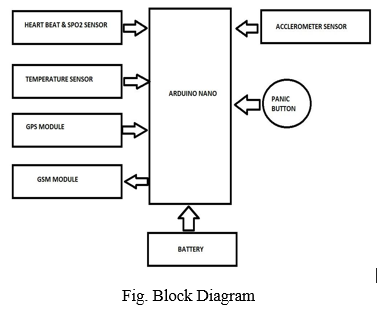
V. APPLICATION REQUIREMENTS
A. Temperature Sensor
It is used to determine the temperature of the child's immediate environment. To achieve average accuracies, the LM35 Sensor does not require any external trimming. The LM35 is temperature-calibrated directly in degrees Celsius (Centigrade). It can be directly connected to an Arduino. The output of the LM35 sensor can either be fed into a comparator circuit and used as a temperature controller, or it can be used as a temperature indicator by using a simple relay. The LM35 gadget runs between 4 and 30 volts and has a temperature range of 55°C to 150°C. It provides a 0.5°C precision guarantee (at 25°C), is low-cost due to wafer-level trimming, and has a current draw of less than 60 mA.
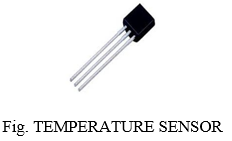
B. Heartbeat and SpO2 Sensor
Maxim's MAX30100 integrated pulse oximetry and a heart-rate sensor are included in the Heart Rate click. It's an optical sensor that measures the absorbance of pulsating blood through a photodetector after emitting two wavelengths of light from two LEDs - a red and an infrared one. This specific LED colour combination is ideal for reading data with the tip of one's finger. A low-noise analogue signal processing device processes the signal before sending it to the target MCU through the mikroBUS I2C interface. Excess motion and temperature variations might also have a negative impact on the measurements. Furthermore, too much pressure can limit capillary blood flow, reducing the data's trustworthiness. There's also a programmable INT pin. This device runs on a 3.3V power supply.
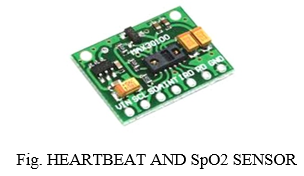
C. Battery
The LG INR18650 M26 2600mAh Lithium-Ion Battery is a high-performance battery that provides excellent value for money. It has a capacity of 2600mAh and a rated voltage of 3.7 volts. With a capacity of 2600 mAh, it is a single cell, small, and powerful battery cell. Features:
- High energy density
- High working voltage for single battery cells
- Pollution-free with a Long cycle lif
- No memory effect
- Capacity, resistance, Voltage, platform time consistency is good.
- Lightweight, small size
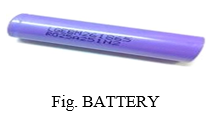
D. GPS
The NEO 6M GPS is used as the basis for a complete GPS module. This unit contains a larger built-in 25 x 25mm active GPS antenna with a UART TTL socket and uses the latest technology to provide the finest possible positioning information. The wearable device's GPS position sensor sends accurate latitude and longitude coordinates to the registered smartphone. TX, RX, VCC, and GND are the four pins on the GPS module's serial TTL output. The u-center software can be downloaded to configure the GPS, change the settings, and much more. When the panic button is pressed, the device's or the child's current GPS location is relayed to the user's phone.
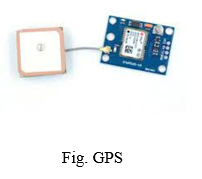
E. GSM
The Global System for Mobile Communications module is intended for SMS monitoring. Small SIM800L GPRS GSM Module Micro SIM Card Core Board Quad-band TTL Serial Port with antenna (two antennas included in this module). A small GSM modem, the SIM800L GSM/GPRS module. This module may be used to perform practically whatever a basic mobile phone can, such as send and receive SMS text messages, make and receive phone calls, connect to the internet via GPRS, TCP/IP, and so on. When the panic button is touched, a text message is sent to the registered phone, coupled with a phone call and a live GPS location. Nano delivers periodic updates to the caretaker through SMS using this module.
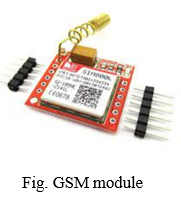
F. Arduino Nano
The ATmega328-based Nano Arduino is a tiny, comprehensive, and breadboard-friendly board (Nano R3). It just has a DC power jack and uses a Mini-B USB cable rather than a conventional one. The Nano can be powered by a mini-USB cable, a 6-20V unregulated external power supply (pin 30), or a 5V regulated external power supply (pin 31). (pin 27). The highest voltage source is automatically picked as the power supply. The Nano V3.0 with CH340 Chip is just 43 mm x 18 mm in size, and it features 6 PWM I/O out of a total of 14 digital I/O, 8 analogue inputs, a 16Mhz clock speed, and 32kB of flash memory.
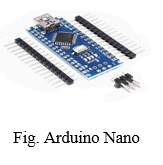
G. Accelerometer
The data from the accelerometer is analysed using several threshold values if there is any sudden fall movement. The user-supplied parameters, such as height, weight, and degree of activity, are used to adjust the threshold.
H. Panic Button
When a child feels threatened in any situation, he or she can press the panic button, which sends an automatic message and a phone call to the parent or guardian, as well as a precise live GPS location. We don't need an internet connection because we're using a GSM module.
I. Blynk Application
Blynk is an IOS and Android platform for controlling Arduino, Raspberry Pi, and other Internet-connected devices. It's a digital dashboard where you may drag and drop widgets to create a graphic interface for your project.
VI. FUTURE SCOPE
A camera module for surveillance of the child's surrounds can be added to improve the system's performance. It's also possible to do it with a Raspberry Pi and Lilypad. It is possible to develop a more energy-efficient type that can keep the battery for a longer period of time.
Conclusion
This wearable device has a superior mode for viewing and locating the children\'s whereabouts with correct latitude and longitude, which is especially useful when using Google maps. This could assist to reduce the number of attacks on children while also making them feel protected and secure. The major goal of this project is to create a device that protects youngsters from risky circumstances while also assisting them in combating them.
References
[1] 1.B. Mallick and A. K. Patro, \"Heart Rate Monitoring System Using Finger Tip Through Arduino And Processing Software\", International Journal of Science Engineering and Technology Research (IJSETR), vol. 5, no. 1, January 2016, ISSN 2278-7798. [2] Dustin T. Weiler, Stefanie O. Villajuan, Laura Edkins, Sean Cleary and Jason J. Saleem, \"Wearable Heart Rate Monitor Technology Accuracy in Research: A Comparative Study between PPG and ECG Technology\", Proceedings of the Human Factors and Ergonomics Society 2017 Annual Meeting. [3] Marius Valerian Paulet, Oana Maria Neacsu and Andrei Salceanu, \"Wireless monitoring system of the heart rate\", 2014 International Conference and Exposition on Electrical and Power Engineering (EPE), ISBN 978-1-4799- 5849-8. [4] Kala Venugopal and Amit Kumar, \"Centralized Heart Rate Monitoring and Automated Message Alert System using WBAN\", International Journal of Scientific and Research Publications, vol. 3, no. 9, September 2013, ISSN 2250-3153. [5] Kainat Zeba, Lakshmi S Patil, Sanjana R Gowda, R Varsha and Shobha Chandra K, \"Real Time Heart Attack and Heart Rate Monitoring Android Application\", International Journal of Computer Science and Mobile Computing, vol. 7, no. 4, pp. 115-124, April 2018, ISSN 2320-088X. [6] Yuan-Hsiang Lin, I-Chien Jan, P. C. -. Ko, Yen-Yu Chen, Jau-Min Wong and Gwo-Jen Jan, \"A wireless PDA-based physiological monitoring system for patient transport\", IEEE Transactions on Information Technology in Biomedicine, vol. 8, no. 4, pp. 439-447, Dec. 2004. [7] H. Ren, H. Jin, C. Chen, H. Ghayvat and W. Chen, \"A Novel Cardiac Auscultation Monitoring System Based on Wireless Sensing for Healthcare\", IEEE Journal of Translational Engineering in Health and Medicine, vol. 6, pp. 1-12, 2018. [8] A. Hodge, H. Humnabadkar and A. Bidwai, \"Wireless Heart Rate Monitoring and Vigilant System\", 2018 3rd International Conference for Convergence in Technology (I2CT), pp. 1-5, 2018.
Copyright
Copyright © 2022 Mr. Raghavendrachar S, Sunaina Nayak, Vishnupriya D, Ruba Abdul Rahman, Krithika K N. This is an open access article distributed under the Creative Commons Attribution License, which permits unrestricted use, distribution, and reproduction in any medium, provided the original work is properly cited.

Download Paper
Paper Id : IJRASET41432
Publish Date : 2022-04-13
ISSN : 2321-9653
Publisher Name : IJRASET
DOI Link : Click Here
 Submit Paper Online
Submit Paper Online

